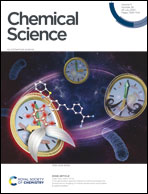Redox-controlled chalcogen-bonding at tellurium: impact on Lewis acidity and chloride anion transport properties†
Abstract
Our interests in the chemistry of atypical main group Lewis acids have led us to devise strategies that augment the affinity of chalcogen-bond donors for anionic guests. In this study, we describe the oxidative methylation of diaryltellurides as one such strategy along with its application to the synthesis of [Mes(C6F5)TeMe]+ and [(C6F5)2TeMe]+ starting from Mes(C6F5)Te and (C6F5)2Te, respectively. These new telluronium cations have been evaluated for their ability to complex and transport chloride anions across phospholipid bilayers. These studies show that, when compared to their neutral Te(II) precursors, these Te(IV) cations display both higher Lewis acidity and transport activity. The positive attributes of these telluronium cations, which originate from a lowering of the tellurium-centered σ* orbitals and a deepening of the associated σ-holes, demonstrate that the redox state of the main group element provides a convenient handle over its chalcogen-bonding properties.



 Please wait while we load your content...
Please wait while we load your content...